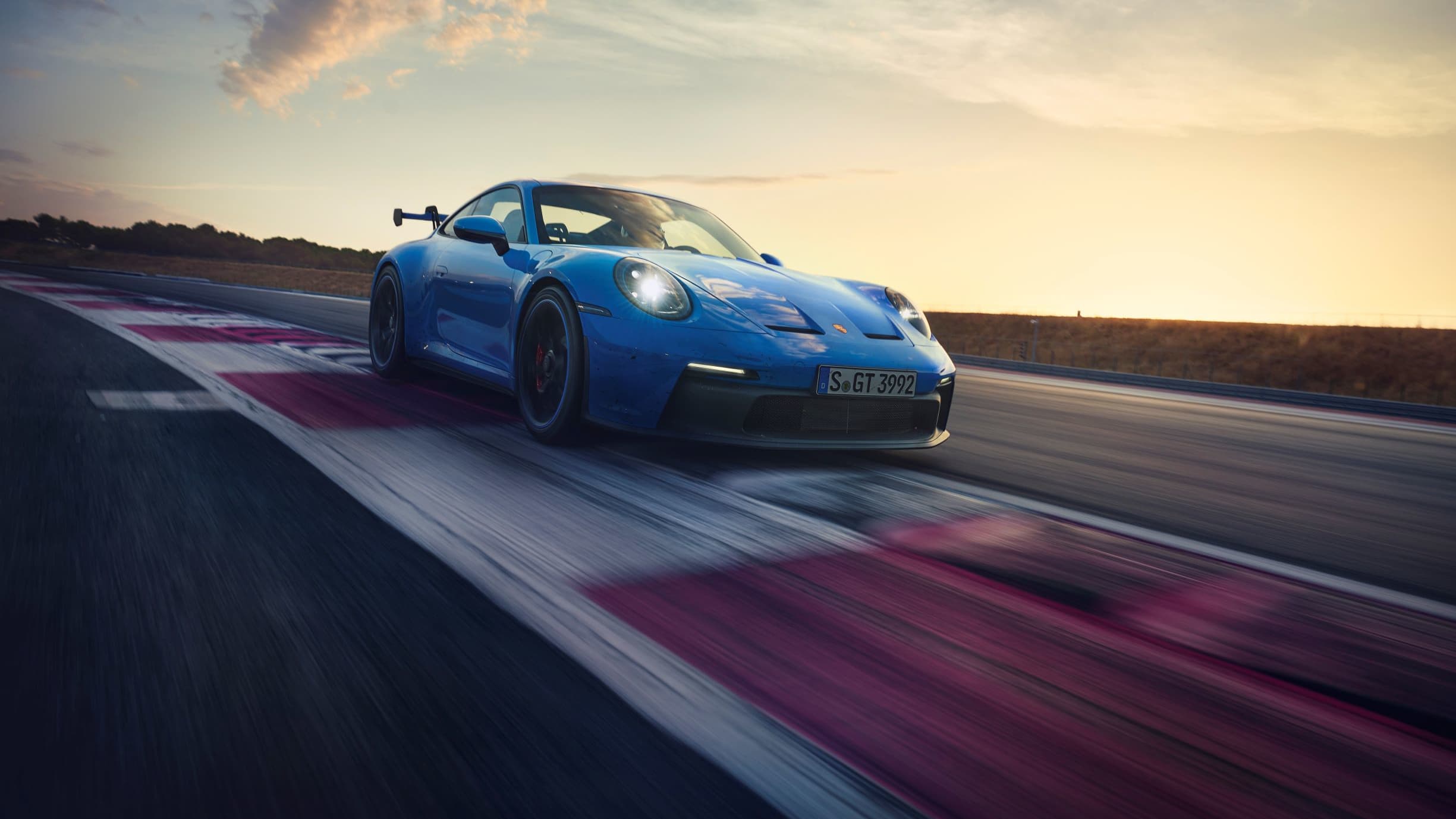The newest Porsche 911 GT3 is quicker than ever, if you can believe it.
The latest iteration of the track-hungry Porsche 911 GT3 features improved front suspension, a towering wing, and that classic high-revving engine.
By Collin Morgan
Wed, Feb 17, 2021 12:42 PM PST
The Porsche 911 GT3 has long been an excellent choice for a track day road car. Porsche makes it a mission to transfer proven race technology to their cars, and the GT3 might benefit the most.
The 2022 GT3 is the fourth generation of the GT3, and Porsche is thankfully sticking to the tried-and-true recipe of bare bones agility and speed.
Porsche reveals that the 2022 911 GT3 features extensive lightweight materials, refined aerodynamics, and a game-changing double wishbone front axle layout.
The naturally-aspirated 4.0L six-cylinder engine revs to 9,000 RPM – yes, 9,000 – and produces 502 horsepower and 346 lb-ft. of torque. The engine features six individual throttle bodies for immediate throttle response.
Porsche is also offering either a seven-speed Porsche Doppelkupplung (PDK) transmission or a six-speed manual transmission for the purists.
The 2022 GT3 features an unequal-length control-arm front suspension for the first time, which is straight out of the 2013 911 RSR. This greatly improves camber stability, maintaining the negative camber used to navigate corners, which keeps a larger tire patch on the pavement.
Porsche claims that the downforce on the 2022 911 GT3 is 50% more than the preceding GT3 generation. With that huge wing, I don’t doubt it.
Look for the 2022 Porsche 911 GT3 to hit dealer showrooms in Fall 2021.
Full specs and report below.

“With a soul that’s born in the Motorsport, the new 911 GT3 sends a driver’s heart racing,” said Kjell Gruner, President and CEO of Porsche Cars North America, Inc. “Whether it’s a customer enjoying their favorite twisty backroad or taking to the track, the new 911 GT3 promises to be among the most exciting and rewarding cars we make.”
Engine: The heart and soul of a racer
A naturally aspirated 4.0-liter, six-cylinder boxer engine that revs to 9,000 rpm is at the heart of the new model. Generating up to 502 hp and 346 lb-ft of torque, the engine offers extremely sharp throttle response thanks in large part to its six independent throttle bodies.
This engine is virtually identical to the unit found in the new, track-only 911 GT3 Cup race car. The seven-speed Porsche Doppelkupplung (PDK) transmission – engineered and tuned specifically for the 911 GT3 – is included as standard equipment, while a six-speed manual transmission is also available to order for customers who prefer a particularly engaging driving experience.
This engine, which was first introduced in the limited-production 2019 911 Speedster, has been further optimized for use in the new 911 GT3 with new pistons. A dry-sump lubrication system ensures a sufficient oil supply even at very high lateral and longitudinal loads by using a total of seven suction stages that quickly return oil to the external tank.
Acceleration from 0 to 60 mph with the standard seven-speed PDK takes only 3.2 seconds and top track speed is 197 mph.
Lightweight materials
The free-revving engine is only a one part of what makes the latest GT3 such a standout. Based on the 911 Carrera body, front track width increases by 1.9 inches. Despite the change in size, the new model weighs almost virtually the same as its predecessor. This is possible thanks in part to a more extensive application of lightweight materials in the body than ever before in a 911 GT3.
The hood, rear wing, and fixed rear spoiler underneath the wing are all made of carbon fiber reinforced plastic (CFRP). Lightweight, noise insulated glass on all of the windows also aids in accomplishing the ambitious weight target.
Chassis and brakes
Narrowing the gap between race and road cars even further, the double wishbone front axle of the new GT3 is derived from the 911 RSR and 911 GT3 Cup cars and adapted for road use, marking a major milestone in the history of the 911. The new front axle offers even more direct and precise steering than the predecessor.
Cornering stability improves, allowing for higher cornering speeds and better mid-corner control over uneven pavement. As with past models, the rear axle uses a multilink design, but for this generation an even greater number of ball joints in both the front and rear are used, further enhancing the capability of the GT3 chassis. In fact, the new GT3 suspension does not share any parts with the current 911 Carrera models.
The standard braking system also boasts improvements over the predecessor model with cast iron discs measuring 408-mm in diameter on the front axle, which is a 28-mm increase over the previous generation.
Despite sharing a diameter with the recently introduced 911 Turbo models, the discs used for the GT3 are approximately 17 percent lighter due largely to the use of a narrower friction ring. Porsche Ceramic Composite Brakes (PCCB) are also available as an additional cost option.
The optional system includes rotors with a diameter of 410 mm in the front and 390 mm in the rear that offer weight savings of about half compared to similarly sized cast iron brake discs and significantly improved thermal load capacity. The ability to deal with very high heat is achieved primarily through special cooling channels in the brake discs as well as newly developed, highly efficient ventilation of the brakes.
GT-specific forged alloy wheels with a 20” diameter in front and 21” diameter in the rear contribute to the overall improvement in vehicle dynamics. The front wheels are half an inch wider than the wheels of the previous GT3, and gain an inch of diameter in the rear.
Despite increased width, the new wheels are also about 3.5 lbs (1.6 kg) lighter in total as compared to the wheels on the preceding model. Customers may also specify pin striping on the wheel in either Shark Blue or Guards Red.
Complementing the new wheels, specifically developed ultra high performance summer tires that are 10 mm wider at both the front and rear, now measuring 255/35ZR 20 on 9.5J x 20 front wheels and 315/30 ZR 21 on 12J x 21 wheels at the rear.
For drivers who desire an even more track-focused setup, Porsche is offering a street legal track tire – previously reserved for RS models – for the first time. These tires were used to complete the benchmark laps set at the Nürburgring.
The new 911 GT3 lapped the 12.944 mile (20.832 km) configuration of the most demanding track in the world, the Nürburgring-Nordschleife, in 6:59.927 minutes. This is where the 911 GT3 demonstrates its capabilities in impressive fashion.
During final testing, it lapped the Nürburgring-Nordschleife, traditionally the ultimate proving ground for all sports car developed by Porsche, over 17 seconds quicker than its predecessor.
Aerodynamics
Aerodynamics also play a critical role in the improved performance capability of the new model. The new front fascia includes integrated cooling intakes as well as an adjustable front spoiler lip and an adjustable front diffuser that can be set up in stages for track use.
Specifically developed side skirts optimize airflow around the wheels, but the most visually striking aerodynamic development lies at the rear where swan-neck connections support the rear wing, and a large rear diffuser is visible. As in the front, the rear wing is manually adjustable in stages ranging from settings intended for road use to positions intended for use only on tracks.
Even in the “normal” position, aerodynamic downforce is up to 50 percent greater compared to the preceding 911 GT3. When the performance position, which is not intended for street use, is applied to both the front and rear, downforce increases by up to approximately 150 percent.
Interior

The connection to racing continues inside where a GT3 Multifunction Sport steering wheel with a 360 mm diameter and upholstery in Race-Tex is standard equipment. For the first time in a 911 GT3, the steering wheel also includes a drive mode switch, allowing the driver to switch between driver configurable settings by simply turning the dial.
Four-way Sport Seats Plus are included as standard, while 18-way Sport Seats Plus and carbon fiber Full Bucket Seats, the latter of which save roughly 26 lbs. compared to the standard seats, are available as extra cost options. While most of the interior is closely related to other eighth-generation 911 models, one difference in particular is plainly obvious: the gear selection lever.
Specifically designed for the GT3, the PDK gear selection lever is based on an adapted version of the manual transmission gearshift lever. Unlocking it to change gear selections is possible by pressing on the shift pattern visible on the top. Additionally, this design allows for manual upshifts and downshifts without the use of the paddles.
There is also a GT-specific “Track Screen” function that reduces the amount of information in the screens surrounding the analog tachometer to the bare essentials and groups that remaining information closely around the central dial so that remains easily visible. Tire pressure and water temperature are always visible on the left, and on the right the display is individually configurable.
The Chrono Package continues to be available as an additional cost option. This feature, which differs from the Sport Chrono Package found on many other Porsche models, adds an analog stopwatch on the dashboard and a digital stopwatch in the instrument cluster. This also adds Lap Trigger support. The Lap Trigger, which is available through Porsche Tequipment, allows for very precise measurement of lap times that can be analyzed and compared on a smartphone using the Porsche Track Precision app.
Market launch and availability
The new Porsche 911 GT3 is expected to arrive in U.S. as a part of the 2022 model year, reaching dealers by Fall 2021. Market specific pricing and order availability will be announced closer to that time.
About The Author

Collin Morgan is a Grand Rapids, Michigan based writer and enjoys the unique and unusual aspects of the automotive industry. He has experienced the worldwide car culture firsthand and has visited the automotive shrines of Ferrari, Lamborghini, and Pagani in Central Italy, tackled the Autobahn, and toured Wales with a rally club. Back in the States, he frequents car events in Detroit and Chicago and is convinced Michigan is the most underrated state for picturesque drives. He owns a 1999 Miata and has happily allowed many good hair days to be ruined by the open road turbulence.







